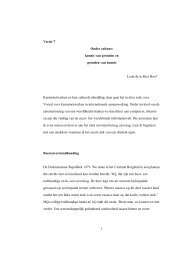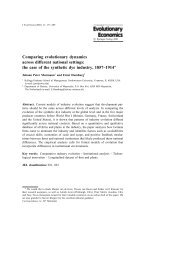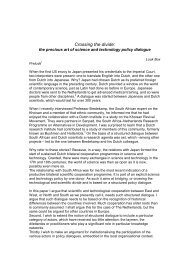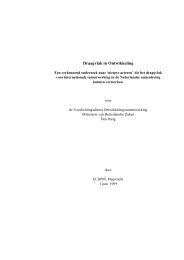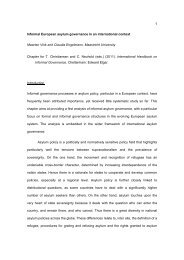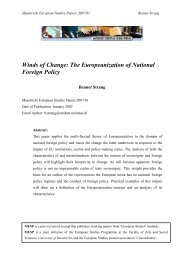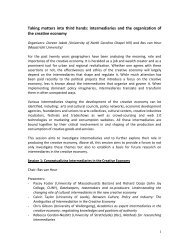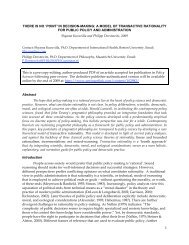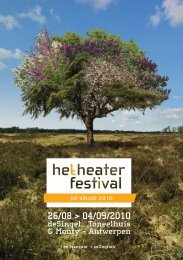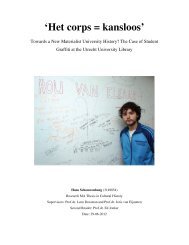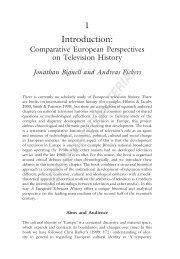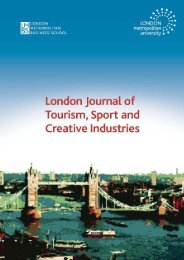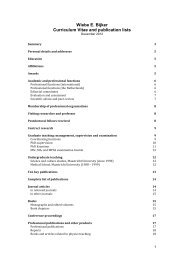Download paper - Maastricht University
Download paper - Maastricht University
Download paper - Maastricht University
You also want an ePaper? Increase the reach of your titles
YUMPU automatically turns print PDFs into web optimized ePapers that Google loves.
<strong>Maastricht</strong> European Studies Papers 2007/07 L. Unbehauen<br />
student-centered learning (p. 47). Also my own university, the <strong>University</strong> of <strong>Maastricht</strong>, has<br />
picked up this new approach by focusing on so-called Problem-Based Learning, which<br />
involves a great amount of self-study and extensive group discussions on the learned content.<br />
Furthermore, many governments have failed to inform both students and employers on the<br />
value and meaning of the bachelor and to restructure their own public service employment<br />
practices (p. 15). Both issues are a reason for the only reluctantly growing acceptance of the<br />
new degree structures in society.<br />
Second, concerning recognition the Diploma Supplement has been implemented by all<br />
member countries by 2005. However, due to technical problems (software programs, data<br />
flow between universities and central administration etc.) and troubles with translation, some<br />
institutions do not issue to all graduates (case in Greece, Denmark and Germany),<br />
automatically (in Central and Eastern Europe), free of charge (in Hungary, Serbia and<br />
indirectly in Turkey) and a widely spoken European language (in Hungary and Romania only<br />
issued in national language) (ESIB, 2005, p. 34/35). Both the Trend IV and the ESIB report<br />
regard, its main weakness remains the lack of inclusion of learning outcomes, as well as<br />
program details which would […] to supply the necessary information on the knowledge and<br />
proficiency of the degree-holder (Reichert & Tauch, 2005, p. 27; ESIB, 2005, p. 35/36). The<br />
majority of Higher Education Institutes (HEIs) use ECTS as a unit for both accumulation and<br />
transfer (in Austria, Belgium, Czech Republic, Estonia, France, Germany, Hungary, Ireland,<br />
Italy, Latvia, Lithuania, the Netherlands, Romania, Sweden and Switzerland) or are at least<br />
working on its implementation (Bulgaria, Croatia, Finland, Poland, Spain and Portugal), while<br />
the UK and Turkey still limit the use of ECTS to student mobility only (Reichert & Tauch,<br />
2005, p. 23). The fact that HEIs decide independently on how much ECTS should be granted<br />
for a certain module leads to diverging and sometimes even contradicting practices. ESIB<br />
criticizes that professors roughly estimate the workload (which provides the basis for the<br />
amount of credits obtained), instead of referring to student input when calculating the ECTS<br />
amount 10 . Thus it can be said that the student workload is inappropriately measured because it<br />
is mostly based on contact hours with professors, neglecting the students’ time spent on self-<br />
study (ESIB, 2005, p. 47). Simply put, it can still not be relied upon that one ECTS in one<br />
country equals one ECTS in another country.<br />
Thirdly, Trend IV findings prove that a correlation exists between improved QA<br />
within institutions and the level of institutional autonomy (Reichert & Tauch, 2005, p. 7). It<br />
has been shown that HEIs in countries that grant most institutional autonomy (namely UK,<br />
10 Good practices in obtaining student input for the calculation of ECTS exist in Estonia, Finland, the<br />
Netherlands, Norway and the UK (ESIB, 2005, p. 44).<br />
16



